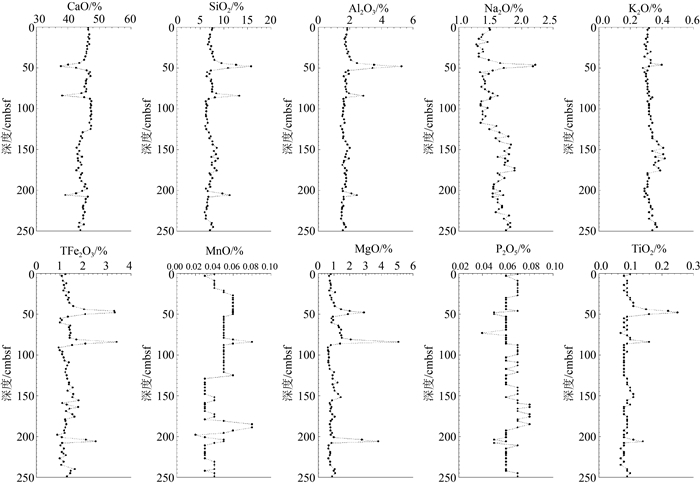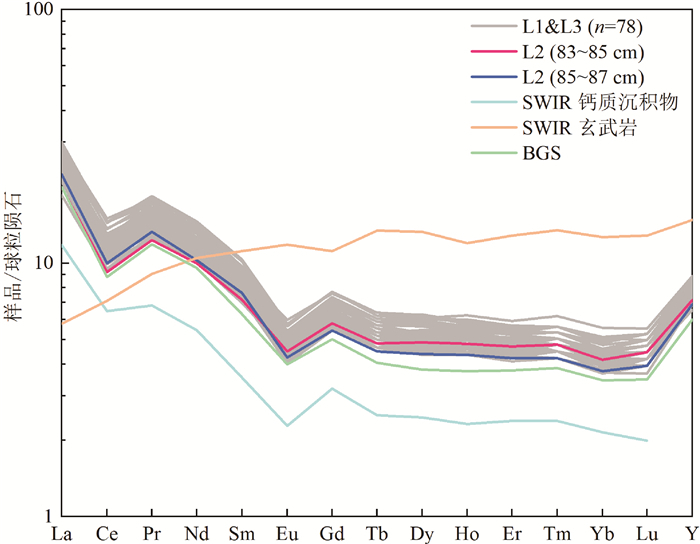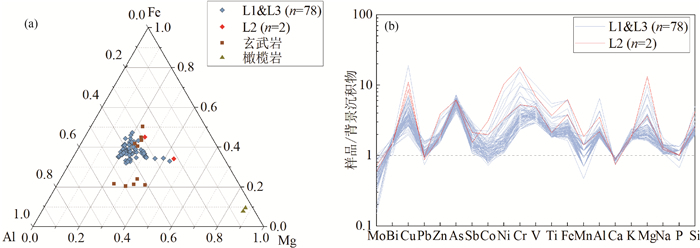Geochemistry and provenance of the sediment core from the rift valley of the Southwest Indian Ridge(49.58°E)
-
摘要:
目前有关西南印度洋中脊沉积物的研究多集中在洋脊翼表层沉积物,对洋脊轴部裂谷沉积物的研究较匮乏,制约了对该区沉积物物质来源和沉积环境的深入认识。针对大洋49航次在洋脊轴部裂谷(东经49.58°)获取的沉积物岩心(GC03)进行了全岩样品主量、微量、稀土元素和Y(REY)含量测试分析,探讨研究区沉积物的物质来源和沉积环境。结果表明,GC03岩心样品富CaO、LOI(烧失量)和Sr,指示以钙质生物沉积占主导,并混有玄武岩碎屑。稀土元素总量(ΣREY)低,平均为54.3×10-6,稀土元素球粒陨石标准化配分图显示轻稀土元素富集,Ce和Eu显著负异常特征。其中L2层(83~87 cmbsf)富集Cu、Zn、Fe、Co等金属元素及较低的100*Al/(Al+Fe+Mn)值,揭示存在热液组分输入。Ceanom值与微量元素V/(V+Ni)-U/Th判别指标指示,研究区总体为偏氧化环境,部分层位显示还原特征。
Abstract:The current research on the sediments of the Southwest Indian Ridge(SWIR) mainly focuses on the surface sediments of the flank of the ridge, but lack of research on its ridge axis restricts the in-depth understanding of the sediment sources and sedimentary environment in this area.Based on the major element, trace element, REE and Y assay of a sediment core(GC03) collected from SWIR 49.58°E during Chinese DY-49 Cruise, the material source and sedimentary environment of the sediments in the study area were discussed.The results show that the bulk samples are enriched in CaO, LOI and Sr, indicating that calcareous biodeposition is dominant and mixed with basalt debris.The content of the ΣREY is low, with average value of 54.3×10-6, and the chondrite-nomalized REY distribution patterns show the enrichment of LREE compared to HREE and significant negative Ce and Eu anomaly.The enrichment of metal elements such as Cu、Zn、Fe and Co, and low 100*Al/(Al+Fe+Mn)value characterizing samples from Layer L2(83-87 cmbsf)reveals the presence of a hydrothermal component input.The Ceanom value and V/(V+Ni)-U/Th discriminant diagram indicate that the study area is generally a stable oxidized environment except for reduction characteristics exhibited from partial samples.
-
Key words:
- Southwest Indian Ridge /
- sediment core /
- geochemistry /
- provenance /
- sedimentary environment
-

-
表 1 GC03岩心样品主量、微量和稀土元素测试结果
Table 1. Assay results of major, trace elements and REE of the sediment core GC03
元素 GC03(n=80) BGS[13](n=4) 最小值 最大值 平均值 中位数 标准差 最小值 最大值 平均值 中位数 标准差 CaO 37.80 47.50 45.03 45.30 2.00 50.53 51.46 50.97 50.94 0.39 SiO2 5.95 15.82 7.54 7.24 1.62 2.51 3.71 3.12 3.13 0.62 Al2O3 1.42 5.28 1.83 1.73 0.53 0.68 0.99 0.81 0.79 0.13 TFe2O3 0.89 3.40 1.42 1.30 0.48 0.44 0.62 0.55 0.56 0.08 K2O 0.28 0.42 0.33 0.32 0.03 0.16 0.19 0.18 0.18 0.02 MgO 0.62 5.09 1.08 0.85 0.70 0.37 0.42 0.38 0.37 0.03 MnO 0.02 0.08 0.05 0.05 0.01 0.04 0.05 0.04 0.04 0.01 Na2O 1.28 2.22 1.58 1.56 0.19 0.97 1.66 1.24 1.17 0.31 P2O5 0.04 0.08 0.06 0.06 0.01 0.02 0.13 0.06 0.05 0.05 TiO2 0.07 0.25 0.09 0.09 0.03 0.03 0.05 0.04 0.04 0.01 Mo 0.06 0.41 0.21 0.20 0.08 0.35 0.44 0.40 0.40 0.04 Bi 0.06 0.11 0.09 0.09 0.01 0.04 0.07 0.06 0.06 0.01 Cu 35.60 344.00 75.59 64.80 41.62 11.60 21.60 18.05 19.50 4.58 Pb 3.50 7.50 5.08 4.90 0.76 3.20 8.70 4.70 3.45 2.67 Zn 22.00 56.00 27.20 26.00 6.31 13.00 15.00 14.25 14.50 0.96 Ag 0.01 0.11 0.03 0.02 0.02 0.01 0.02 0.01 0.01 0.01 As 7.70 13.90 10.87 10.85 1.32 1.70 2.10 1.90 1.90 0.18 Sb 0.16 0.45 0.26 0.24 0.08 0.13 0.17 0.15 0.15 0.02 Co 4.80 20.50 8.04 7.45 2.62 4.70 9.20 6.58 6.20 2.00 Ni 15.60 149.50 30.31 23.60 21.28 11.40 20.60 14.33 12.65 4.23 Cr 13.00 100.00 24.38 19.50 16.39 5.00 6.00 5.50 5.50 0.58 V 16.00 55.00 22.34 20.00 6.59 4.00 7.00 5.50 5.50 1.29 Y 12.80 17.40 14.57 14.20 1.04 9.00 15.60 11.75 11.20 2.91 Sr 1140.00 1800.00 1659.88 1675.00 106.34 - - - - - Th 0.97 1.90 1.42 1.41 0.14 - - - - - U 0.30 3.70 0.98 0.70 0.78 - - - - - ∑REY 47.83 66.16 54.31 53.01 4.60 34.94 54.07 43.37 42.24 9.12 LREE 26.85 40.56 32.64 32.17 3.14 21.15 31.13 25.67 25.21 5.05 HREE 6.24 8.82 7.10 6.93 0.64 13.79 22.94 17.70 17.04 4.13 LREE/HREE 3.48 5.14 4.61 4.59 0.29 1.36 1.53 1.46 1.47 0.08 δEu* 0.61 0.73 0.66 0.66 0.03 0.67 0.75 0.71 0.70 0.03 δCe* 0.55 0.65 0.58 0.58 0.02 0.52 0.65 0.57 0.56 0.06 Ceanom* -0.27 -0.19 -0.25 -0.25 0.02 -0.31 -0.21 -0.27 -0.27 0.04 注:主量元素含量单位为%,微量和稀土元素含量单位为10-6;δEu=2×(Eu/EuN)/(Sm/SmN+Gd/GdN),δCe=2×(Ce/CeN)/(La/LaN+Pr/PrN),Ceanom=lg(3CeN/(2LaN+NdN)),“*”表示采用球粒陨石标准化;“-”表示数据缺失;BGS—西南印度洋表层背景沉积物,离洋中脊大于60 km,代表洋盆附近沉积 表 2 GC03岩心主量和微量元素相关系数(n=80)
Table 2. The correlated coefficient of major and trace elements in GC03 core
CaO SiO2 Al2O3 TFe2O3 K2O MgO MnO Na2O P2O5 TiO2 LOI Mo V Cr Co Ni Cu Zn Pb As Sb Ba Sr Zr Hf Th U ∑REY CaO 1 SiO2 -0.857 1 Al2O3 -0.678 0.917 1 TFe2O3 -0.816 0.938 0.810 1 K2O -0.401 0.192 0.016 0.239 1 MgO -0.734 0.810 0.633 0.838 -0.057 1 MnO -0.081 0.348 0.383 0.392 -0.338 0.382 1 Na2O -0.774 0.533 0.443 0.508 0.629 0.266 -0.228 1 P2O5 0.043 -0.159 -0.245 -0.166 0.477 -0.335 -0.131 0.142 1 TiO2 -0.732 0.924 0.955 0.865 0.123 0.672 0.365 0.508 -0.178 1 LOI 0.612 -0.917 -0.932 -0.870 0.070 -0.774 -0.494 -0.262 0.324 -0.902 1 Mo -0.190 0.282 0.387 0.265 -0.130 0.179 0.413 0.157 -0.212 0.432 -0.327 1 V -0.746 0.866 0.854 0.829 0.200 0.632 0.262 0.594 -0.133 0.850 -0.804 0.246 1 Cr -0.767 0.901 0.797 0.872 -0.086 0.960 0.386 0.329 -0.368 0.809 -0.878 0.273 0.742 1 Co -0.726 0.740 0.556 0.837 0.149 0.828 0.321 0.415 -0.266 0.582 -0.673 0.143 0.663 0.779 1 Ni -0.682 0.746 0.551 0.780 -0.095 0.985 0.376 0.197 -0.351 0.578 -0.718 0.142 0.570 0.925 0.842 1 Cu -0.160 0.260 0.209 0.343 -0.094 0.340 0.222 0.041 -0.147 0.187 -0.304 0.088 0.436 0.304 0.531 0.384 1 Zn -0.843 0.894 0.703 0.896 0.200 0.916 0.286 0.473 -0.175 0.762 -0.794 0.125 0.762 0.908 0.817 0.883 0.334 1 Pb -0.283 0.056 -0.096 0.017 0.745 -0.197 -0.326 0.532 0.563 -0.046 0.207 -0.283 0.110 -0.206 -0.085 -0.240 -0.259 0.076 1 As -0.221 0.032 -0.109 -0.027 0.143 0.036 -0.106 0.245 0.193 -0.157 0.134 -0.329 0.057 -0.029 0.172 0.086 0.210 0.105 0.310 1 Sb -0.167 0.095 0.104 0.057 0.293 -0.075 -0.269 0.301 0.186 0.073 -0.047 -0.026 0.384 -0.052 0.155 -0.050 0.319 0.087 0.299 0.265 1 Ba -0.139 -0.139 -0.355 -0.131 0.702 -0.193 -0.505 0.320 0.404 -0.315 0.363 -0.426 -0.150 -0.289 -0.020 -0.172 -0.088 0.005 0.716 0.291 0.334 1 Sr 0.689 -0.903 -0.898 -0.834 -0.085 -0.677 -0.404 -0.388 0.220 -0.919 0.884 -0.474 -0.780 -0.809 -0.558 -0.598 -0.178 -0.720 0.098 0.195 0.011 0.335 1 Zr -0.743 0.772 0.728 0.685 0.578 0.389 0.028 0.704 0.038 0.774 -0.612 0.191 0.746 0.504 0.442 0.305 0.038 0.638 0.410 0.041 0.301 0.194 -0.685 1 Hf -0.569 0.612 0.609 0.542 0.447 0.291 0.072 0.542 -0.030 0.643 -0.499 0.186 0.612 0.402 0.339 0.217 -0.080 0.486 0.324 -0.012 0.167 0.109 -0.554 0.834 1 Th 0.173 -0.307 -0.409 -0.348 0.663 -0.501 -0.323 0.029 0.651 -0.361 0.468 -0.336 -0.315 -0.544 -0.395 -0.487 -0.328 -0.312 0.664 0.123 0.176 0.619 0.310 0.110 0.110 1 U 0.121 -0.175 -0.119 -0.259 0.112 -0.199 -0.311 0.011 0.090 -0.166 0.143 -0.145 0.104 -0.207 -0.132 -0.161 0.063 -0.084 0.159 0.125 0.734 0.274 0.219 0.051 0.018 0.227 1 ∑REY -0.239 0.060 -0.074 0.024 0.808 -0.243 -0.306 0.436 0.561 0.007 0.178 -0.268 0.090 -0.237 -0.132 -0.288 -0.310 0.028 0.869 0.173 0.270 0.656 -0.008 0.494 0.446 0.806 0.143 1 -
[1] Yu Z, Li H, Li M, et al. Hydrothermal signature in the axial-sediments from the Carlsberg Ridge in the northwest Indian Ocean[J]. Journal of Marine Systems, 2016, 180: 173-181. http://www.sciencedirect.com/science/article/pii/S0924796316303773
[2] Agarwal D K, Roy P, Prakash L S, et al. Hydrothermal signatures in sediments from eastern Southwest Indian ridge 63°E to 68°E[J]. Marine Chemistry, 2020, 218: 1-16.
[3] Mitchell N C. Creep in pelagic sediments and potential for morphologic dating of marine fault scarps[J]. Geophysical Research Letters, 1996, 23(5): 483-486. doi: 10.1029/96GL00421
[4] 黄大松, 张霄宇, 张国堙, 等. 西南印度洋中脊48.6°~51.7°E沉积物地球化学特征[J]. 地质科技情报, 2016, 35(1): 22-29. https://www.cnki.com.cn/Article/CJFDTOTAL-DZKQ201601004.htm
[5] Gurvich E G. Metalliferous sediments of the world ocean: Fundamental theory of deep-sea hydrothermal sedimentation[M]. Berlin, New York: Springer, 2006: 80-120.
[6] Cave R R, German C R, Thomson J. Fluxes to sediments underlying the Rainbow hydrothermal plume at 36°14'N on the Mid-Atlantic Ridge[J]. Geochimica et Cosmochimica Acta, 2002, 66(11): 1905-1923. doi: 10.1016/S0016-7037(02)00823-2
[7] Hannington M, Jamieson J, Monecke T, et al. The abundance of seafloor massive sulfide deposits[J]. Geology, 2011, 39(12): 1155-1158. doi: 10.1130/G32468.1
[8] Tao C, Lin J, Guo S, et al. First active hydrothermal vents on an ultraslow-spreading center: Southwest Indian Ridge[J]. Geology, 2012, 40(1): 47-50. doi: 10.1130/G32389.1
[9] Dias Á S, Barriga F J A S. Mineralogy and geochemistry of hydrothermal sediments from the serpentinite-hosted Saldanha hydrothermal field (36°34'N; 33°26'W) at MAR[J]. Marine Geology, 2006, 225(1/4): 157-175.
[10] Dick H J B, Lin J, Hans S. An ultraslow-spreading class of ocean ridge[J]. Nature, 2003, 426(6965): 405-412. doi: 10.1038/nature02128
[11] 陈圆圆, 于炳松, 苏新, 等. 西南印度洋中脊钙质沉积物地球化学及矿物学特征[J]. 地质科技情报, 2013, 32(1): 107-113. https://www.cnki.com.cn/Article/CJFDTOTAL-DZKQ201301021.htm
[12] 张霄宇, 陶春辉, 廖时理, 等. 西南印度洋洋中脊表层沉积物地球化学特征及其热液活动指示[J]. 沉积学报, 2020, (4): 727-736. https://www.cnki.com.cn/Article/CJFDTOTAL-CJXB202004003.htm
[13] Liao S, Tao C, Li H, et al. Surface sediment geochemistry and hydrothermal activity indicators in the Dragon Horn area on the Southwest Indian Ridge[J]. Marine Geology, 2018, 398: 22-34. doi: 10.1016/j.margeo.2017.12.005
[14] Liao S, Tao C, Dias Á A, et al. Surface sediment composition and distribution of hydrothermal derived elements at the Duanqiao-1 hydrothermal field, Southwest Indian Ridge[J]. Marine Geology, 2019, 416: 1-11. http://www.sciencedirect.com/science/article/pii/S0025322719300969
[15] 宋备, 苏新, 吕士辉, 等. 西南印度洋中脊活动与非活动热液区沉积物元素地球化学特征对比[J]. 现代地质, 2020, 34(1): 130-140. https://www.cnki.com.cn/Article/CJFDTOTAL-XDDZ202001012.htm
[16] 刘明, 孙晓霞, 石学法, 等. 印度洋钙质软泥和硅质软泥稀土元素组成和富集机制[J]. 海洋学报, 2019, 41(1): 58-71. https://www.cnki.com.cn/Article/CJFDTOTAL-SEAC201901007.htm
[17] 林震, 于洪军, 徐兴永, 等. 西南印度洋中脊扩张轴部(34.9°S)西翼沉积物地球化学分析及物源探讨[J]. 海洋地质与第四纪地质, 2018, 38(5): 14-29. https://www.cnki.com.cn/Article/CJFDTOTAL-HYDZ201805002.htm
[18] Georgen J E, Lin J, Dick H J B. Evidence from gravity anomalies for interactions of the Marion and Bouvet hotspots with the Southwest Indian Ridge: Effects of transform offsets[J]. Earth and Planetary Science Letters, 2001, 187(3/4): 283-300. http://www.sciencedirect.com/science/article/pii/S0012821X0100293X
[19] Tao C, Seyfried W E, Lowell R P, et al. Deep high-temperature hydrothermal circulation in a detachment faulting system on the ultra-slow spreading ridge[J]. Nature Communications, 2020, 11(1): 1300. doi: 10.1038/s41467-020-15062-w
[20] Chen J, Tao C, Liang J, et al. Newly discovered hydrothermal fields along the ultraslow-spreading Southwest Indian Ridge around 63 E[J]. Acta Oceanologica Sinica, 2018, 37(11): 61-67. doi: 10.1007/s13131-018-1333-y
[21] Li H, Tao C, Yue X, et al. Enhanced hydrothermal activity on an ultraslow-spreading supersegment with a seismically detected melting anomaly[J]. Marine Geology, 2020, 430: 1-12. http://www.sciencedirect.com/science/article/pii/S0025322720302231
[22] Kolla V, Bé A W H, Biscaye P E. Calcium carbonate distribution in the surface sediments of the Indian Ocean[J]. Journal of Geophysical Research, 1976, 81(15): 2605-2616. doi: 10.1029/JC081i015p02605
[23] 于淼, 苏新, 陶春辉, 等. 西南印度洋中脊49.6°E和50.5°E区玄武岩岩石学及元素地球化学特征[J]. 现代地质, 2013, 27(3): 497-508. doi: 10.3969/j.issn.1000-8527.2013.03.001
[24] Taylor S R, McLennan S M. The continental crust: its composition and evolution[M]. Oxford: Blackwell Scientific, 1985: 1-312.
[25] 朱赖民, 高志友, 尹观, 等. 南海表层沉积物的稀土和微量元素的丰度及其空间变化[J]. 岩石学报, 2007, 23(11): 2963-2980. doi: 10.3969/j.issn.1000-0569.2007.11.027
[26] Dymond J. Geochemistry of Nazca plate surface sediments: An evaluation of hydrothermal, biogenic, detrital, and hydrogenous sources[J]. Geological Society of America, 1981, 154(154): 133-174. http://www.researchgate.net/publication/284664574_Geochemistry_of_Nazca_Plate_surface_sediments_An_evalution_of_hydrothermal_biogenic_detrital_and_hydrogeneous_sources
[27] Pietrek H. Saharan dust transport over the North Atlantic Ocean[J]. Geological Society of America, 1981, 186: 87.
[28] McCave I N, Kiefer T, Thornalley D J R, et al. Deep flow in the Madagascar-Mascarene Basin over the last 150, 000 years[J]. Philosophical transactions. Series A, Mathematical, physical, and engineering sciences, 2005, 363(1826): 81-99. http://www.ncbi.nlm.nih.gov/pubmed/15598625
[29] Kuhn T, Burger H, Castradori D, et al. Volcanic and hydrothermal history of ridge segments near the Rodrigues Triple Junction (Central Indian Ocean) deduced from sediment geochemistry[J]. Marine Geology, 2000, 169(3/4): 391-409. http://www.sciencedirect.com/science/article/pii/S0025322700000803
[30] 韩宗珠, 张贺, 范德江, 等. 西南印度洋中脊50°E基性超基性岩石地球化学特征及其成因初探[J]. 中国海洋大学学报(自然科学版), 2012, 42(9): 69-76. https://www.cnki.com.cn/Article/CJFDTOTAL-QDHY201209013.htm
[31] Nath B N, Bau M, Rao B R, et al. Trace and rare earth elemental variation in Arabian Sea sediments through a transect across the oxygen minimum zone[J]. Geochimica et Cosmochimica Acta, 1997, 61(12): 2375-2388. doi: 10.1016/S0016-7037(97)00094-X
[32] Chavagnac V, German C R, Milton J A, et al. Sources of REE in sediment cores from the Rainbow vent site (36°14'N, MAR)[J]. Chemical Geology, 2005, 216(3/4): 329-352. http://www.sciencedirect.com/science/article/pii/S0009254104004838
[33] McArthur J M, Elderfield H. Metal accumulation rates in sediments from Mid-Indian Ocean Ridge and Marie Celeste Fracture Zone[J]. Nature, 1977, 266(5601): 437-439. doi: 10.1038/266437a0
[34] Liang J, Tao C, Yang W, et al. 230Th/238U Dating of Sulfide Chimneys in the Longqi-1 Hydrothermal Field, Southwest Indian Ridge[J]. Acta Geologica Sinica, 2018, 93(S2): 77-78. http://www.geojournals.cn/dzxbcn/ch/reader/create_pdf.aspx?file_no=2018endzxbz2059
[35] Huang X, Chen S, Zeng Z, et al. The influence of seafloor hydrothermal activity on major and trace elements of the sediments from the South Mid-Atlantic Ridge[J]. Journal of Ocean University of China, 2017, 16(5): 775-780. doi: 10.1007/s11802-017-3311-y
[36] Jones B, Manning D A C. Comparison of geochemical indices used for the interpretation of palaeoredox conditions in ancient mudstones[J]. Chemical Geology, 1994, 111(1/4): 111-129. http://www.sciencedirect.com/science/article/pii/000925419490085X
-




 下载:
下载:





